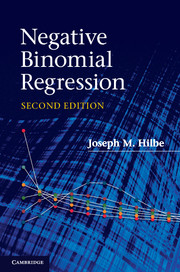Book contents
- Frontmatter
- Contents
- Preface to the second edition
- 1 Introduction
- 2 The concept of risk
- 3 Overview of count response models
- 4 Methods of estimation
- 5 Assessment of count models
- 6 Poisson regression
- 7 Overdispersion
- 8 Negative binomial regression
- 9 Negative binomial regression: modeling
- 10 Alternative variance parameterizations
- 11 Problems with zero counts
- 12 Censored and truncated count models
- 13 Handling endogeneity and latent class models
- 14 Count panel models
- 15 Bayesian negative binomial models
- Appendix A Constructing and interpreting interaction terms
- Appendix B Data sets, commands, functions
- References and further reading
- Index
10 - Alternative variance parameterizations
Published online by Cambridge University Press: 05 June 2012
- Frontmatter
- Contents
- Preface to the second edition
- 1 Introduction
- 2 The concept of risk
- 3 Overview of count response models
- 4 Methods of estimation
- 5 Assessment of count models
- 6 Poisson regression
- 7 Overdispersion
- 8 Negative binomial regression
- 9 Negative binomial regression: modeling
- 10 Alternative variance parameterizations
- 11 Problems with zero counts
- 12 Censored and truncated count models
- 13 Handling endogeneity and latent class models
- 14 Count panel models
- 15 Bayesian negative binomial models
- Appendix A Constructing and interpreting interaction terms
- Appendix B Data sets, commands, functions
- References and further reading
- Index
Summary
Negative binomial regression has traditionally been used to model otherwise overdispersed count or Poisson data. It is now considered to be the general catchall method used when Poisson data are found to be overdispersed, particularly when the source of overdispersion has not been identified. When we can identify that which gives rise to extra correlation, and hence overdispersion, the basic Poisson and negative binomial algorithms may themselves be further adjusted or enhanced to directly address the identified source of extra correlation. For example, when overdispersion results from an excess of zero counts in the response, an appropriate strategy is to model the data using either a zero-inflated Poisson (ZIP) or zero-inflated negative binomial (ZINB). Employing a hurdle model may also result in a better fit. On the other hand, if the response is structured such that zero counts are not possible, as in hospital length-of-stay data, a zero-truncated Poisson (ZTP) or zero-truncated negative binomial (ZTNB) model may be appropriate.
A variety of alternative models have been developed to address specific facts in the data that give rise to overdispersion. Models dealing with an excess or absence of zeros typically define a mixture that alters the distributional assumptions of the Poisson distribution. Other models are constructed to alter not the probability and log-likelihood distributions, but rather the Poisson and negative binomial variance functions. We discuss these types of models in this chapter.
- Type
- Chapter
- Information
- Negative Binomial Regression , pp. 284 - 345Publisher: Cambridge University PressPrint publication year: 2011



